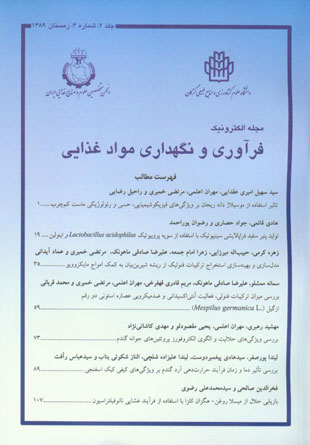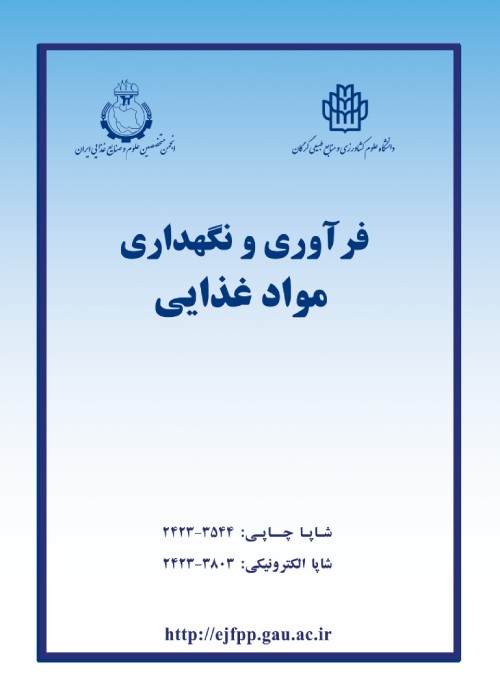فهرست مطالب

نشریه فرآوری و نگهداری مواد غذایی
سال دوم شماره 4 (پیاپی 8، زمستان 1389)
- 128 صفحه،
- تاریخ انتشار: 1391/11/01
- تعداد عناوین: 7
-
Page 1In this study effect of basil seed mucilage at three concentration levels (0, 0.1, 0.15 and 0.2%) on the physicochemical, sensory and rheological properties of low fat yoghurt during 15 day of storage was investigated. The results of this research showed addition of mucilage had no effect on acidity of samples. In term of synersis, all concentration levels of basil seed mucilage, decreased synersis. The highest lightness was observed in negative control and increasing mucilage concentration decreased lightness of samples. By addition of seed mucilage viscosity decreased as sample containing 0.2% basil seed mucilage had the lowest viscosity. Firmness of samples decreased when seed mucilage concentration increased but there was no significant difference between concentration of 0.15 and 0.2%. The highest and lowest adhesiveness observed in sample containing 0.15% mucilage and positive control sample, respectively. The results of this study showed that basil seed mucilage could be used to improvement of physicochemical characteristics of low fat yoghurt.Keywords: Low fat yoghurt, Basil seed mucilage, Rheological properties, Synersis
-
Page 19In this study productivity of synbiotic UF white cheese with probiotic strains of Lactobacillus acidophilus and inulin as a prebiotic compound at the levels of 2 % and 4 % was investigated. Cheese samples were ripened at 6°C for 60 days and the viability of probiotic strain and chemical composition such as, dry matter, pH, Salt, protein, fat were assayed during ripening days. Cheese samples also were analyzed for textural properties by using texture profile analysis (TPA) and sensory evaluation during ripening period. The results showed that the numbers of Lactobacillus acidophilus were 8.23 log cfu/gr at the first day of production. These figure reached to 6.06 log cfu/gr after 45 days and to 5.77 log cfu/gr after 60 days of ripening, respectively. Whereas, lowest reduction of Lactobacillus acidophilus number at the 45th and 60th day were observed in samples with 2% inulin and reached to 6.24 and 5.86 log cfu/gr, respectively. The numbers of live probiotic cells were higher than those recommended for beneficial effect at the end of 45th day. pH of all cheese were decreased, while salt, acidity content increased and the fat content and dry matter of all cheeses were not change significantly (P>0.05) during storage. The sensory evaluation showed that the samples with 2% inulin acquired the high score of texture and flavor. Textural profile showed decreasing ofhardness & gumminess at the end of ripening days.Keywords: Ultrafiltration white cheese, Probiotic, Inulin, Synbiotic
-
Page 33In present study, response surface methodology was used to optimize extraction condition of phenolic compounds from licorice root by microwave application. Investigated factors were solvent (ethanol 80%, methanol 80% and water), liquid/solid ratio (10:1, 17.5:1, 25:1) and time (2, 4 and 6min). Experiments were designed according to the central composite rotatable design. The results showed that extraction conditions had significant effect on the extraction yield of phenolic compounds and antioxidant capacities. Optimal condition in microwave assisted method were ethanol80% as solvent, extraction time of 5-6 min and liquid/solid ratio of 16.5/1. Amount of phenolic compounds and extraction yield of licorice root in microwave assisted (MAE), were 47.43 mg/g and 16.38%, respectively. The antioxidant activity of optimal extract was assessed by DPPH, reducing power and total antioxidant capacity assay and results were compared with synthetic antioxidant BHT.Keywords: Modeling, Optimization, Microwave assisted extraction, Licorice root, RSM
-
Page 57In this study, total phenolics content, antioxidant and antimicrobial activity of acetonic extract of two Medlar types, wild and domestic, were evaluated. Phenolic compound were extracted with acetone. Total phenolic content of acetonic extract of wild and domestic type were 7.53 and 4.45 g GAE/ gr dry powder, respectively. Extracts were also tested for their antioxidant activities using scavenging activity of DPPH radicals, total antioxidant capacity and reducing power test and compared with synthetic antioxidant. In all tests, extract from wild type showed highest antioxidant activity than another type. The antibacterial effects of the extracts were assessed on three gram positive and three gram negative bacteria by micro broth dilution technique using ELISA reader. The extracts also showed good antimicrobial activity against all of tested microorganisms and the tested gramnegative bacteria showed higher resistant to the inhibitory effect of extracts. The ranges of minimum bactericidal concentration (MBC) of the extracts were 0.615-5 and 1.25-10 mg/ml for wild and domestic type, respectively.Keywords: Medlar, Antimicrobial activity, Radical scavenging activities
-
Page 71Wheat germ is one of main part of wheat kernel that contains relatively high protein content. These proteins cause desired functional properties. Among the functional properties of proteins, solubility is of the most importance, because of its significant influence on the other functional properties. Many factors affect the protein solubility. Two of the most important factors are pH and NaCl concentration. In the alkaline extraction method, maximum solubility of proteins is important and affects the extraction efficiency. An integrate study was conducted on the effects of salt concentration and pH on the solubility of defatted wheat germ proteins. The solubility profile of defatted wheat germ protein also determined as affected by pH 1-12. The solubility at acidic pH values decreased towards the pH value of 4, that is the isoelectric point and then increased for basic pH values, and then solubility reached to maximum level at pH 10. The solubility was determined experimentally in the 0, 0.1, 0.25, 0.5, 0.75 and 1 M NaCl solutions and pH 9, 9.5, 10, 10.5, in order to obtain optimum pH and salt concentration for protein extraction. The results showed that, both salt concentration and pH influenced in the protein solubility, and these properties had great interaction. The protein solubility was higher at pH value of 10 than other pH for all NaCl solutions, however, the maximum solubility was observed at pH 10 in 0.5 M NaCl concentration. The results of the present study indicated that the protein solubility of the defatted wheat germ flour was adversely affected by increasing ionic strength, although the protein solubility in 0.1 to 0.5 M NaCl solutions was similar nearly. The highest protein solubility was observed in 0.5 M NaCl and pH 10. Therefore, it can be concluded that optimum pH and salt concentration for protein extraction from defatted wheat germ are 10 and 0.5 M, respectively. Also, in order to understand the protein subunits distribution profile, and comparison structure of protein isolate from alkaline extraction and defatted wheat germ flour, electrophoresis patterns were determined.Keywords: Wheat germ protein, Solubility, pH, Salt concentration, Electrophoresis
-
Page 87In this study, the effect of heat treatment on soft wheat flour with low gluten content on cake batter characteristics and the quality of final product was investigated. Physical properties of cake batter such as specific gravity and consistency, properties of cake such as volume, specific volume, apparent density, solid density, apparent porosity, moisture, symmetry and uniformity, color and firmness (at 1st, 7th and 14th days after production) and the final score of sensory evaluation were evaluated. Results showed that increasing time and temperature of dry heat led to a decrease in specific gravity of cake batter, cake moisture content and an increase in the batter consistency, cake volume, specific volume and cake apparent porosity. However, moist heat (steam) application on the flours (even at a very short steaming period) decreased the latter parameters. Control and heat treated samples has similar solid densities. The best cake symmetry and uniformity were obtained for product obtained from heat treated flours at temperatures of 110 and 120 °C for 120 min. Higher crust color values were obtained for cakes prepared from steamed flours. Crumb color for all treatments was almost similar. At 7th and 14th days of evaluation, control cakes showed the firmest crumbs, while cakes prepared from steamed flours and heat treated flours (at temperatures of 110 and 1200c for 120 min) showed the softest crumbs. Overall, sponge cakes prepared from dry heat treated flours presented better acceptability for the sensory judges.Keywords: Wheat flour, Heat, Cake, Quality, Physical, Sensory characteristics
-
Page 121High energy consumption during the recovery of solvent from oils miscella in traditional method, the experts urged is to find new ways to reduce energy consumption in oil extraction industry. Therefore in this study, the nanofiltration (NF) membrane potential to recycle of the hexane solvent from oil/hexane miscella of canola has been studied. In this work, the effect of transmembrane pressure (1.5, 2.0 and 2.5 MPa at three levels) and temperature (20, 30 and 40°C at three levels) on the efficiency of NF process was investigated. The polyamide tubular AFC40 membrane manufactured by PCI membrane systems in a pilot plant system was used in study. Results of temperature and pressure effects on the flux of pure hexane showed that hexane flux increases with increasing operating temperature and pressure. The advantages of using this type of membrane was the stability of the polyamide membrane against solvent and the results of flux profiles versus time showed little change over time in hexane flux is found. According to the type and membrane pore size used in this study were showed that only hexane able to pass through the pores of the membrane and entered in the permeate stream and other compounds found in miscella (including free fatty acids and triglycerides) as retentate back into the feed tank. The results mean the canola miscella flux was increases with increasing temperature and pressure. Because the select the appropriate type and pores size of membrane, fouling of the membrane removed with several times circulation with pure solvent through a membrane and the membrane can be re-used. According to the results, can be propose 30°C and 2.5 Mpa, as the best temperature and pressure for NF process of canola oil/hexane miscella in oil extraction industry.Keywords: Canola, Flux, Hexane, polyamide, Solvent Recovery, Triglyceride


